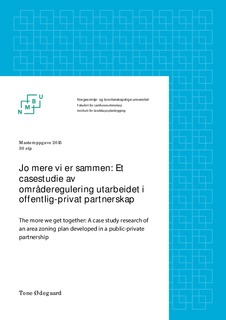| dc.description.abstract | Liberalisme og markedets inntog i den fysiske planleggingen har ført til mange
private reguleringsplaner og en fragmentert utvikling. For å bidra til en mer helhetlig
planlegging og fremme kommunens posisjon som samfunnsutvikler, ble
områderegulering innført som en ny plantype i 2008. Områderegulering er i
utgangspunktet en kommunal plan, men det åpnes likevel opp for at private kan
utarbeide hele eller deler av planen. Denne studien tar for seg en tredje mulighet, der
områderegulering utarbeides i et offentlig-privat samarbeid mellom kommunen og
privat utbygger.
Studiens hovedproblemstilling spør om partnerskapet for utarbeidelse av
områderegulering kan bidra til mer helhetlig utvikling. Problemstillingen besvares
med et empirisk casestudie av planprosessen tilknyttet det fremtidige boligområdet på
Myrvoll | Ekornrud i Oppegård kommune. Ved hjelp av nettverksteori, dialogbaserte
planteorier og institusjonell teori analyseres caset for å gi et innblikk i hvordan
partnerskapet har påvirket gjennomføringen av planprosessen og prosessens utfall.
Studien avdekker at partnerskap mellom kommune og utbygger for å utarbeide en
områderegulering kan bidra til mer helhetlig utvikling. Partnerskapet har i denne
plansaken fungert som en kommunikativ arena der partenes ulike perspektiver ble
utvidet og en felles forståelse for planområdets fremtid ble dannet. Dette ga en
realistisk forestilling om en fremtidig utvikling i området, både fra et økonomisk og et
langsiktig perspektiv. Det vises likevel at de positive effektene av partnerskapet
vanskelig kan forankres i områdereguleringen som plandokumentet. I stedet er disse
forankret i intensjonsavtaler mellom partene i form av visjon, masterplan og
kvalitetsprogram og iboende i aktørene selv. Det argumenteres derfor for at disse
strategiske planene er mer vesentlige enn selve områdereguleringen for å skape
helhetlig utvikling, både ved at de danner en felles retning for partnerskapet underveis
i planprosessen, men også i tiden fremover for å vurdere om fremtidige utbygginger
følger opp prosjektets intensjoner.
Liberalism and market entry in the physical planning in Norway has led to many
private plans and a fragmented development. To contribute to a more comprehensive
planning and promote the municipality's position as a community developer, the area
zoning plan was introduced as a new type of plan in 2008. The area zoning plan is
mainly a plan reserved for the government, but the law still opens up for participation
from private developers in the planmaking process. This thesis examines the situation
where an area zoning plan is developed in a public-private partnership between the
municipality and the private developer.
The thesis research question is: can a partnership for the making of area zoning plans
contribute to more comprehensive planning? The question is examined with an
empirical case study of the planning process for the future residential area Myrvoll |
Ekornrud in Oppegård. Using network theory, dialogue-based planning theories and
institutional theory the case is analysed to give an insight into how the partnership has
affected the implementation of the planning process and the process outcomes.
The examination reveals that the partnership between the government and the
developer to prepare an area zoning plan may contribute to more comprehensive
development. The partnership functioned as a communicative arena where the
participants different perspectives was enlarged and a shared understanding of the
area's future development was formed. This gave a realistic notion of a future
development in the area, both from an economic and a long-term perspective. It
appears, however, that the positive effects of the partnership could not be maintained
in the area zoning plan alone. Instead, these effects are maintained in the vision, the
master plan, the quality program and in the participant themselves. I therefor argue
that these strategic plans are more significant than the actual area zoning plan to
create comprehensive development because they form a shared mission for the
partnership during the planning process, but also in the future to assess whether future
developments will be in accordance to the project's intentions. | nb_NO |
